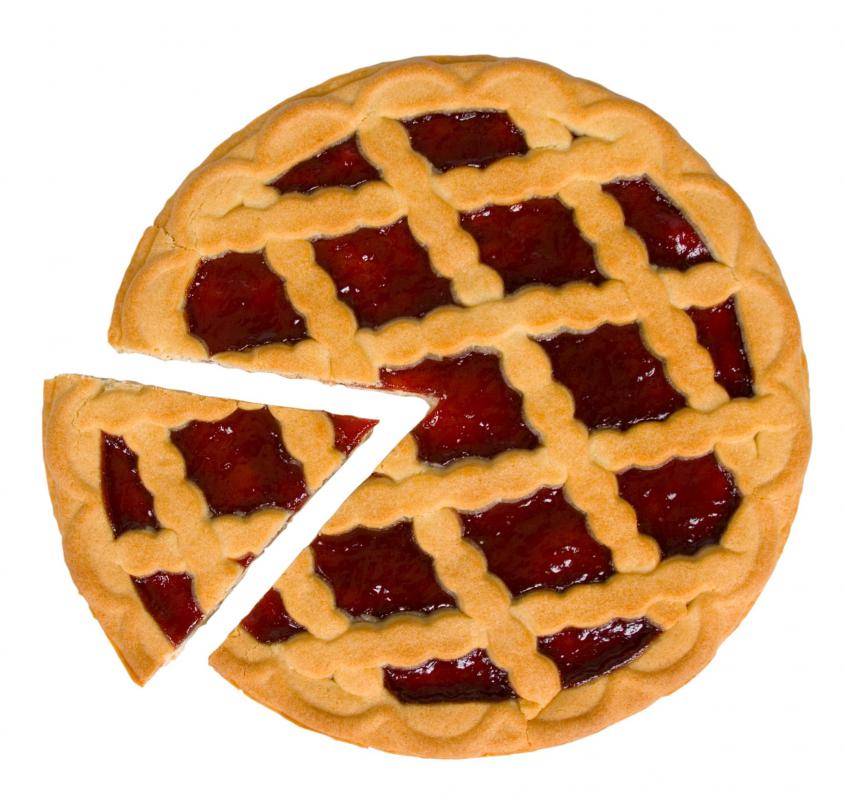At DelightedCooking, we're committed to delivering accurate, trustworthy information. Our expert-authored content is rigorously fact-checked and sourced from credible authorities. Discover how we uphold the highest standards in providing you with reliable knowledge.
What is a Pie Crust Shield?
Many people who bake pies are frustrated when the edges of the crust begin to brown faster than the center of the crust. Some crusts will burn while the interior is still not cooked thoroughly, or the top crust center is still pale and unattractive. Burning edges of a crust doesn’t add to the attractiveness of a pie, and this problem can be particularly pronounced when you’re baking custard pies with no top crust, or pies with relatively hard fruit like apples that need a longer cooking time. Alternately, if you like to crimp the crust close to the edge of the pie tin, as with a fork, the thinner crust at the edges cooks faster. For this reason, many pie bakers celebrate the pie crust shield.
A pie crust shield is a useful utensil in the kitchen and comes in several forms. The most common are rings made of aluminum, which are gently placed over the pie, sometimes halfway through the baking process, to prevent the edges of the crust from burning. You can also buy pie crust shield types that come in several rounded pieces, which can be placed around the exterior crust, and can compensate for larger or smaller pies. Size can vary, and you may need a couple, or multiple piece pie crust shields if you use several different sized pie pans.

One recent addition to pie crust shield materials are those made from silicone instead of aluminum. Some people favor these, as they tend not to stick. Either material will protect the pies edges from getting over-crisped or even burnt, but people do complain that aluminum shields may stick to a certain degree. One way to avoid this is to wait until the edges of the crust are cooked perfectly. They will be hard at this point so there’s little danger of the shield actually sticking to the crust. With any type of shield, you will need to cook the pie for part of the time unshielded so that the edges of the crust are thoroughly cooked.
Pie crust shields are inexpensive, costing between $5-10 US Dollars (USD); the silicone ones tends to be more expensive than aluminum types. Some cooks claim though, that you can have a perfectly prepared pie without ever using one. Instead of purchasing a pie crust shield, simply use some folded over foil around the edges of the pie if it appears to be overcooking. This will keep crust edges from burning, generally won’t stick if you place it on the pie when the crust is already hard, and moreover, can be adapted for any size or shape of pie. You can also recycle aluminum foil providing you rinse it after use.
There are as many fans of the aluminum foil method as of the pie crust shield method for avoiding burned pie edges. Those who favor aluminum foil like the adaptable size of the foil, and some also argue that unless you store a pie crust shield carefully, light aluminum will easily bend out of shape, rendering the shield less useful. Silicone shields tend to fare better, and won’t bend permanently if you store something on top of them.
AS FEATURED ON:
AS FEATURED ON:











Discussion Comments
Or, you can just save yourself $10 and use aluminum foil. It works just fine 99 percent of the time, and it's almost always in the kitchen. You just have to remember to get it out and use it.
I will say a pie crust shield is easy -- just pop it over the crust and you're good to go, but aluminum foil will mold nicely over elaborate crusts, which a pie shield may or may not do.
A pie shield is one of those things that is handy to have in the kitchen, and if you can find one on sale, to pick up. Otherwise aluminum foil is the cheapest thing out there and it's just as effective.
Post your comments